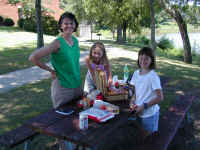
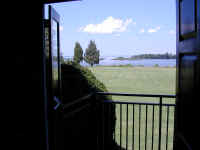
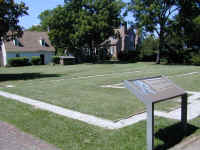
Williamsburg and Jamestown, VA
Colonial History: July 6 to July 11 (Pictures are thumbnails. Click on them for a larger view.)
After our adventures touring Delaware and Maryland and studies in Washington, DC, we departed south to Virginia. There we visited George Washington's birthplace, spent considerable time in Colonial Williamsburg and Jamestown, visited Mt. Vernon, George Washington's farm, and had time left to visit the Busch Gardens theme park in Williamsburg.
We are enjoying a picnic in the yard of the George Washington Birth Place National Monument on the Potomac River. (We really didn't know such a place existed till we looked at a map after getting a little lost leaving Washington. It is about 30 miles east of Fredericksburg.) Next, you see the view from a manor house which was constructed in the 1920s as a Memorial to George [the man] Washington on the supposed site of his birth place home. In the 1930s, some further archeological work was done and they found the foundation of the actual home, outlined in white on the right. The actual home was much smaller and certainly less opulent than the reconstructed home. It was also located further away from the Potomac River, probably hidden from the river by tall red cedars. Why? Because PIRATES could see such a visible home and would not hesitate to come ashore to steal and plunder!
We thoroughly enjoyed our visit to Colonial Williamsburg and spent 2 and 1/2 days there. It was great fun to see the people dressed up in colonial dress and reenacting and explaining how things were done on specific days 1775 and 1776. Steffi and Emma got so excited that they demanded to be able to dress the same way. So, on the second day, we rented them appropriate dresses to wear as you'll see below.
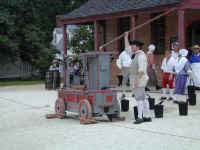
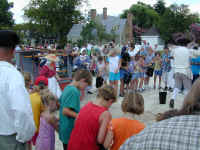
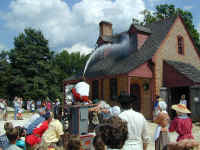
This series of pictures shows a demonstration of fire fighting in the 18th
century. First, they explained that you could not put out a fire once it
started and had grown beyond just a small flame. So, what you were focused
on was keeping the neighbors' houses from burning down too. Here is a
small 'fire engine' that was used during those times. It is actually just
a pump with a large water reservoir on wheels invented by a button-maker in Paris.
(He obviously was cut out to be an engineer
rather than a button-maker and tailor.) The first thing to be
done, once the 'engine' was in place near the fire, was to fill the tanks.
This would be done with a bucket brigade. You can see Steffi and Emma in
the second picture passing buckets with the other kids to fill the tank.
Then, 8 strong men would take places and begin to pump the handles up and down
to maintain water pressure and allow the neighbors' roofs to be soaked with
water.
Children and adults who misbehaved were dealt with in an effective manner. Steffi and Emma are in the stocks for committing some act of mischief or disrespect. A second alternative was to tie your feet up and force you to sit on a pointed board. Steffi and Emma decided that the 20th Century forms of punishment weren't so bad after all. Stephanie is shown as a silversmith's apprentice, pumping his bellows.
Each day in Williamsburg re-enacts an actual day in history. This particular day was May 15, 1776, the day that the Virginia House of Burgesses (their legislative body) decided to vote for independence from England. Their representatives, of which Thomas Jefferson was one, would then go to the second Continental Congress in Philadelphia to cast their vote, along with the other 12 colonies, for independence. The 13 colonies agreed as a group to write the Declaration of Independence from England and publish it on July 4, 1776, marking the birthday of the United States.
Here you see the local representatives giving speeches to the public explaining what had been decided and encouraging the citizens to support the vote for independence. It did not take much convincing. Lots of fifes and drums and hip-hip-hoorays (and huzzah's) cheered them on. Lastly, you see the new flag of the union being raised to replace the flag of England which had until then flown over the House of Burgesses.
Steffi and Emma, finally dressed appropriately (except for their scandalous ankle-baring sandals), are reading a letter that has been delivered to them by their 'cousin' in England asking them to perform a few errands while she is gone. This turned out to be a sort of colonial scavenger hunt which took them to many spots around Williamsburg. They are learning to walk like proper ladies during a theatrical training session, though Emma seems to be having difficulty getting the toe-heel sequence correct. At right they are talking with a lady shop-keeper about the proper courtesies a young lady must know.
All of this lady-like instruction did not keep Emma and Steffi from enlisting in the militia. Here they are in the first rank (facing sideways) holding their practice muskets. They actually got quite good after a few minutes of instruction from the Sergeant (also a lady!), but it was clear they were not headed for a regiment! Their biggest confusion was which arm was left and which was right when holding the musket. One of their other tasks was to get some radish seeds from a store and help the gardener plant them.
They were then to deliver some herbs (rosemary and thyme) to the cook at the Wythe house (the man who helped teach law to Thomas Jefferson) and were very excited to find a modern air conditioner blowing in a corner. It keeps a dress very cool. Also, check out the period wallpaper in the hallway behind them! Finally, they are proud of their day and deeds well done though their manners and lady-like courtesies lasted only a few days! And the flowers are just because Jennifer liked the colorful garden so much.
This is the meeting hall of the House of Burgesses. They were explaining to the public (us) the finances, logic and reasons for getting ready for independence and possible war with England. The right picture is from the Court House. We went through a re-enactment of 18th century justice and heard three actual cases that were brought before the court. You may notice the distinguished justice on the right side of the bench. The head justice took the place in the center as the matters were heard. It was amazing how quickly we all reached agreement on the matters!
A plantation location that is part of Colonial Williamsburg is called Carter's Grove. It is the site of an estate and slave quarters from the 18th century. The first picture shows the conditions that a typical slave would be living in, sleeping on a bed of straw on the floor of a small room, shared with 4 or 5 other people. By contrast, the mansion of the estate owner is very opulent. This house was refurbished over the many years and a portion is shown as it was during World War II. Finally, Stephanie listens as one of the actors explains her role as a slave and later a share-cropper, having had her daughter sold by the master and, later, after the Civil War ended and having found her daughter, but unable to reunite with her because the daughter did not recognize her real mother.
Jamestown is the site of the first English settlement in America. They settled on an island up the James River in 1607 (remember that the Pilgrims in Massachusetts did not arrive until 1620). They built a three sided fort to protect them from the French, pirates, and possibly Indians which is being uncovered today. The Indians actually helped the settlers to survive their first years there. The actual site of the settlement and fort is a National Monument on the island. Nearby, a private museum has reconstructed a replica of the Jamestown Settlement complete with replicas of the three ships they came over in and a Powhatan's Indian village.
In the Powhatan Indian village, a young Indian maiden shows many different animal pelts to Steffi and Emma. They were surprised to learn they would probably still be running around naked at their age! The ship Sarah Constant is a replica of the largest of the three ships to sail to Jamestown. It sailed in OpSail 2000 in Newport News, VA. Stephanie and Emma had fun crawling under the ship's bell.
The biggest building in the Jamestown settlement was the Church, whose reproduction is shown here. Stephanie has fun learning how people carried multiple buckets of water around. Finally, at the Jamestown Site National Monument, a statue of John Smith, the appointed leader of the community and the first governor of Virginia is shown. The statue and a Memorial Church (not shown, but nearby) were built in the 1920s. More interesting, however, are the yellow stakes shown just near the James River bank. These mark what archeologists have very recently found to be one the original walls of the three sided fort. You can also see tarps in the background where current archeological work is underway to uncover the whole site. A second set of yellow stakes marks a second wall of the fort, going under the Memorial Church which was built, obviously, not knowing the exact location of the fort at the time.
After all the adventures
in Williamsburg and Jamestown, Emma and Steffi settle down outside our RV,
Betty, with a good book. Ironically, they were both reading historical
novels of the period. Actually, both are waiting excitedly to read
Harry Potter and the Goblet of Fire.
Steffi and Emma stand on
the farming estate of George Washington in Mt. Vernon, VA. After all they
have learned about Washington, they know that in this part of our country,
GEORGE IS THE MAN. They even coined their own jingle after the
movie, George of the Jungle. It goes:
George, George, George of America!
Boom, Boom, Boom, Ba-Boom!
George, George, George of America!
Watch out for those Red Coats!
(there is more, but we digress...)